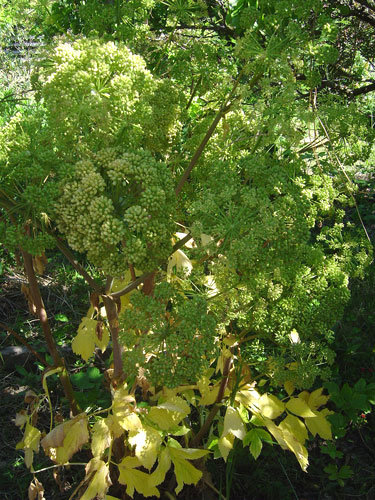Dear reader: wiith other commitments needing to be attended to, I’ve invited my student and East West School editor, Anne de Courtenay, to guest-blog for the sixth day of Kwanzaa. I’ll be back tomorrow with a post on Faith. — Michael Tierra
The theme for today, the sixth day of Kwanzaa, is Kuumba — Creativity: To do always as much as we can, in the way we can, in order to leave our community more beautiful and beneficial than we inherited it.
Closely related to and building upon yesterday’s theme of “Purpose,” our meditation for today has not to do with creation for creation’s sake, but for a directed, purposeful creativity. It is a call for us to draw upon our memories, imaginations and desires to create ways to strengthen and beautify our community, to prepare it to support even more creation and abundance after we are gone.
This type of creativity places an inherent value on community as a foundation from which we draw strength and in which we invest for the future. It’s more than just our group of friends, family, co-workers or our neighborhood — community forms the basis of our identity.
As a bona-fide Generation X-er (and born at the tail-end of that, no less), I certainly do not have the breadth and depth of wisdom Michael has presented in previous posts surrounding the lessons about community learned during his formative years at Black Bear. As the product of a completely urban and post-modern experience, a certain degree of isolation plus a weird hybrid of anonymity and individualism have always shaped my ideas of creativity and community. Only in my mid-20s, when I became more and more involved with my herbalism school in Chicago and later with East West, did I begin to really form and understand what I consider to be a real community experience that has become a significant part of my identity.
It would be no exaggeration to say that many of my generation and later are most likely to learn their lessons about community from the recent explosion of social networking and virtual communities on the Web! So, it may be helpful to dissect what consciously improving one’s flesh-and-blood, mortar-and-brick community might mean in the real world, especially in urban settings where the idea of community itself might be a slightly nebulous concept.
You might ask yourself the following:
- What and who exactly are my community? What binds us together? What values do we share?
- Can I identify something that is missing or that I would like to see developed in my community?
- Why do I think this should be changed or developed, and what do I think my community would look like if it were?
- If such a development would indeed benefit the community, what specifically is my goal and intention?
- Turning my attention once more to look at what resources I have to work with in my community, what sorts of specific actions, in order, might I take to achieve my goal/intention?
Once these questions are addressed and answered, the actual work needed to achieve the goal can begin.
Key to the sort of purposeful creation kuumba describes is the recognition of oneself in the generational continuum of one’s community. Any creation using today’s raw materials should honor our ancestors as well as support our children and our children’s children.
From the standpoint of a student of herbalism, my fellow Chicago students and I travel as often as we can to my teacher’s farm to help care for the specimen gardens and generally maintain the sacred nature sanctuary there. In classes and clinic in the city, we aim to help each other learn with the ultimate goal being to develop ourselves into better healers, thus reaching an even wider community. It is a conscious co-creation with each other, our teachers, our teachers’ teachers, and the elements.
That’s a very narrow example, of course. We can create many ways to better our communities — we can “grow” people through education; we can build structures in which to gather for worship, art appreciation or commerce; we can honor our elders’ dignity and instill that same dignity in our children by providing them with the best care; we can tell stories through various forms of art, plant trees and gardens, and be good stewards of the Earth.
But let’s look at it from a less ambitious perspective: perhaps the most basic and literally nourishing way we can build community is often overlooked: Make and share a meal.
Poem for Kuumba/Creativity: “All that I have comes from my Mother!” by Luisah Teish
All that I have comes from my Mother!
I give myself over to this pot.
My thoughts are on the good,
the healing properties of this food.
My hands are balanced, I season well!
I give myself over to this pot.
Life is being given to me.
I commit to sharing, I feed others.
I feed She Who Feeds Me.
I give myself over to this gift.
I adorn this table with food.
I invite lovers and friends to come share.
I thank you for this gift.
All that I have comes from my Mother!
by Luisah Teish
How can you not feel part of a community when you are either hosting or invited to a meal prepared with love? Healing food prepared and shared with loving intention nurtures community on so many levels. It may not build community in so far-reaching a way as building a library or theater, sure. But it is a relatively simple ritual — and a necessary one to boot! — that can form and strengthen the nucleus of community. Whether it is a large feast or an intimate gathering of family and friends, the shared meal represents community and creativity at their most basic forms.
Teish’s poem covers so much of what kuumba is about: the creation of a meal meant to nourish the community; use of healing foods harvested (probably organically and responsibly!) from Mother Earth, raw materials synthesized together into one delicious dish; generosity and the true spirit of sharing; and gratefulness for the source of the food and life in general, be it the Earth or the ancestors.
The chef finds joy in knowing where her food came from, how it is made, how it will be shared, and whom it will nourish. “I give myself over to this pot,” she says, showing that she is generous with her food as well as her spirit and loving intent. This basic building block of conscious creativity to serve and share with a group can foster a togetherness that prepares all — on a physical and emotional level — to find the energy to better the community in more visible ways.
 Herb for Creativity: Dang Gui
Herb for Creativity: Dang Gui
Angelica sinensis, better known as dang gui, is the premier blood-building herb in the Chinese materia medica. As such, it is a specific tonic for women and is used for all sorts of gynecological complaints, including cramps, irregular periods and other menstrual disorders. It specifically treats symptoms of blood deficiency in both men and women, including ringing in the ears, dizziness, dry skin and hair, fatigue, limited flexibility, brain fog, and blurred vision.
Dang gui is unique as a blood tonic in that it also helps move the blood, which relieves pains of stagnant blood anywhere in the body. Its blood building and moving effects work best when taken in combination with other herbs to enhance its action for specific indications.
So why have I chosen dang gui to represent creativity? For this I choose to look at creativity from a very basic angle.
We all know it takes two to make a baby, but it is the woman who carries it while she and the fetus together create ten little fingers, ten little toes, two little eyes, and so forth. To do this, a woman must have enough blood in her body to support herself and the child within. Dang gui, with its famous blood-building qualities, indeed helps resolve issues of infertility and thus helps prepare a mother for the creation of new life. (Note, because this herb also moves blood, it is contraindicated for use during menses and pregnancy.)
From a slightly more general perspective, the proliferation of Blood, in traditional Chinese medicine, leads to a proliferation of well-nourished and harmonious Qi/energy, and vice versa.
In other words, this herb supports the future by helping to create a strong and safe atmosphere in the present. Sounds like kuumba to me!
As a final note to the nourishing properties of dang gui, and as an addendum to Luisah Teish’s poem above, the Chinese administer this herb in a food-as-medicine stew including mutton or lamb and ginger as a postpartum meal for mothers who are experiencing abdominal pain (due in no small part to blood deficiency, having lost a lot of blood giving birth). The traditional recipe is simply one part dang gui, two parts fresh sliced ginger and five parts mutton simmered in eight cups of water until reduced by half. But here’s a recipe for lamb, dang gui and ginger dumplings which would be fun to make and even more fun to share, especially with anyone in your community who might need a bit more warmth and energy this winter! (And here’s a delicious-sounding recipe for steamed dang gui chicken.)
So, is kuumba/creativity for the sake of bettering our community just about cooking food and making babies? Of course not. These are just metaphors for consciously creating and nourishing a better future of healthy people able to shape a healthy and exuberant community. In any way you can, may you create with others a stronger and more beautiful community in 2009!
Thanks to Michael and East West for the honor and opportunity to contribute my thoughts here! Readers, I invite you to visit my personal blog, Herbis Orbis, for a discussion of a wide range of topics including herbalism, living with the seasons, and music. — Anne de Courtenay

